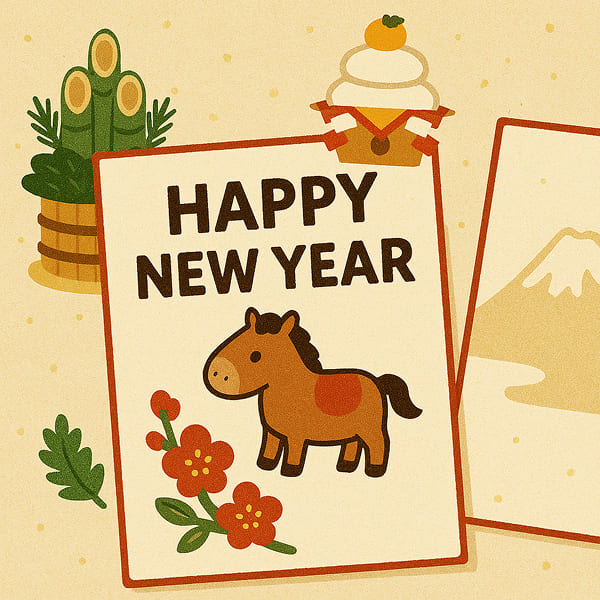The Timeless Tradition of Nengajo: Japan’s New Year Greeting Cards

Contents
What if a simple postcard could carry your gratitude, hopes, and warmth into someone’s New Year?
In Japan, Nengajo(年賀状)—beautifully designed New Year’s greeting cards—do exactly that.
Despite the rise of digital communication, millions still embrace this heartfelt tradition to reconnect with friends, family, and colleagues, sending wishes of joy, health, and prosperity for the year ahead.
Far more than seasonal mail, Nengajo represents a timeless blend of art, emotion, and etiquette—one that continues to enrich relationships across generations.
What is Nengajo? – A Japanese New Year Custom
Nengajo are decorative postcards sent around the New Year to convey warm seasonal greetings.
In Japan, receiving these cards on January 1st is considered a joyful and auspicious start to the year.
People send them to:
- Express appreciation
- Maintain relationships
- Strengthen personal and professional ties
A Brief History of Nengajo
The practice of Nengajo dates back to the Nara period (710–794), when people visited relatives to exchange New Year greetings in person.
As printing technology evolved during the Edo period (1603–1868), these visits transformed into handwritten and printed greeting cards.
By the modern era, Nengajo became a nationwide tradition, supported by Japan’s highly organized postal system.
The Cultural Importance of Sending Nengajo
In Japan, Nengajo are more than just seasonal greetings—they’re a reflection of social etiquette and emotional connection.
Sending Nengajo allows people to:
- Show gratitude for the previous year
- Offer good wishes for the future
- Reinforce bonds in both personal and business relationships
Especially in professional settings, sending a well-crafted Nengajo helps build trust and rapport.
Typical Design and Elements of Nengajo
Each year, Nengajo feature fresh, meaningful designs. One key motif is the zodiac animal of the year (eto), part of the Chinese zodiac cycle.
For example:
- 2025 is the Year of the Snake (巳年)
- 2026 is the Year of the Horse (午年)
Other common elements include:
- Traditional greetings like “Akemashite omedetou gozaimasu” or “Kingashinnen”
- Personal messages reflecting life updates, goals, or well-being
- Symbolic imagery such as Mt. Fuji, the sunrise, or plum blossoms
Adding a handwritten note brings a sincere and personal touch to each card.
When and How to Send Nengajo
To ensure delivery on New Year’s Day, mail your Nengajo by December 25.
Japan Post offers a dedicated service to hold and deliver them exactly on January 1st.
Etiquette Tips for Nengajo
- Avoid using negative words like “death” or “loss”
- Use simple, elegant designs for professional contacts
- Always reply to received Nengajo as a sign of respect
Modern Trends: Digital Nengajo and Social Media
While traditional cards remain popular, e-Nengajo (digital greeting cards) are on the rise—especially among younger generations.
Contemporary trends include:
- Online postcards and customizable templates
- Messages via LINE or email
- Creative branded cards from companies to clients
Even so, the physical Nengajo still holds emotional and cultural value for many.
Nengajo as a Symbol of Gratitude and Connection
At its heart, Nengajo represents:
- Gratitude
- Renewal
- Connection
Whether handwritten or digital, these cards help start the year with positive energy, strengthening social ties and spreading goodwill.
Fun Facts About Nengajo
- Japan’s 12 zodiac animals rotate yearly and shape the card’s theme
- Elegant phrases like “Gasho” and “Geishun” add traditional flair
- Handwriting recipient names and addresses shows deeper thoughtfulness and courtesy
Final Thoughts
Nengajo is more than a postcard—it’s a cultural ritual of kindness, remembrance, and renewal.
As each New Year approaches, these small cards carry with them not just wishes—but connections across time and distance.
So the next time you receive a Nengajo, treasure it.
It’s a window into the warmth and timeless elegance of Japanese tradition.